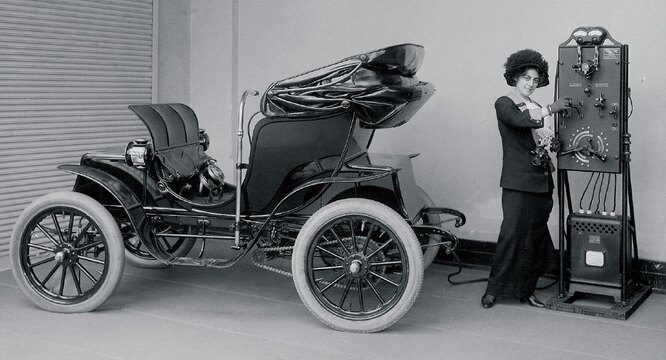
The electric car in history: the first electric cars | Beautiful battery
Content
The electric car is often considered a recent invention or the car of the future. In fact, it has been around since the XNUMXth century: therefore, the competition between combustion-engine cars and electric vehicles is not new.
First prototypes with battery
The first prototypes of electromobiles appeared around 1830. As is the case with many inventions, historians have not been able to pinpoint the exact date and identity of the inventor of the electric car. This is indeed a subject of controversy, however, we can give credit to a few people.
First, Robert Anderson, a Scottish businessman, in 1830 developed a kind of electric cart powered by eight electromagnets powered by non-rechargeable batteries. Then, around 1835, American Thomas Davenport designed the first commercial electric motor and created a small electric locomotive.
Thus, these two electric vehicles are the beginning of the electric vehicle, but they used non-rechargeable batteries.
In 1859, the Frenchman Gaston Planté invented the first rechargeable battery lead acid, which will be improved in 1881 by the electrochemist Camilla Fore. This work has significantly improved battery life and thus gave the electric vehicle a promising future.
The advent of the electric car
The work done on batteries gave birth to the first reliable electric vehicle models.
We first find a model created by Camille Faure as part of his work on the battery, with his French colleagues Nicolas Raffard, a mechanical engineer, and Charles Jeanteau, an automobile manufacturer.
Gustave Fund, electrical engineer and electric vehicle designer, improves electric motor developed by Siemens, equipped with a battery. This engine was first adapted to a boat and then mounted on a tricycle.
In 1881, this electric tricycle was presented as the first ever electric vehicle at the Paris International Electricity Show.
In the same year, two English engineers, William Ayrton and John Perry, also introduced the electric tricycle. This car was more advanced than the one produced by the Gustave Found: a range of about twenty kilometers, a speed of up to 15 km / h, a more maneuverable vehicle and even equipped with headlights.
As the car was more successful, some historians consider it the first electric car, notably the German Autovision Museum.
Rise in the market
At the end of the XNUMX century, the car market was divided into gasoline engine, steam engine and electric motor.
Thanks to the advances made in the tricycle field, the electric vehicle will gradually become industrial and will have some success in the context of economic activity, especially in Europe and the United States. Indeed, other French, American and British engineers will gradually improve electric vehicles to improve their performance.
In 1884 a British engineer Thomas Parker reportedly made one of the first electric vehicles, as seen in the first known photo showing an electric vehicle. Thomas Parker owned Elwell-Parker, a manufacturer of batteries and dynamos.
He is known to have developed the equipment that powered the first electric trams: Britain's first electric tram at Blackpool in 1885. He was also an engineer for the Metropolitan Railway Company and participated in the electrification of the London Underground.
The first electric cars are starting to be marketed, and this is mainly a taxi fleet for city services.
The success is growing especially in the United States, where New Yorkers were able to use the first electric taxis since 1897. The vehicles were equipped with lead-acid batteries and charged at specialized stations at night.
Thanks to the Electrobat model, developed by engineer Henry G. Morris and chemist Pedro G. Salomon, the electric car held 38% of the US automotive market.
Electric car: a promising car
Electric cars have gone down in automotive history and have had their greatest glory days, breaking records and racing. At the time, electric vehicles were outperforming their thermal competitors.
In 1895, an electric car took part in the rally for the first time. This is the Bordeaux-Paris race with the vehicle of Charles Jeanteau: 7 horses and 38 Fulmain batteries of 15 kg each.
In 1899, Camilla Jenatzi's electric car "La Jamais Contente". this is the first car in history to exceed 100 km / h. To discover the incredible story behind this entry, we invite you to read our full article on this topic.
